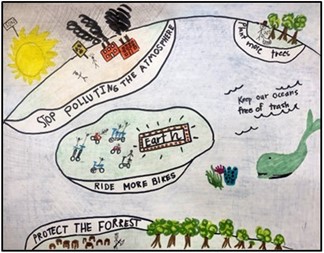
SUBSCRIBE PREVIOUS ISSUES
Featured Article
The Core of a Sustainable Diet
How environmentally friendly are your lunch plans? In this article, we will explore the impacts sustainable diets have on the environment and how that intersects with health.
A “sustainable diet” cannot be prescriptive in what it does or does not contain since it could be unique to an individual’s physiology, culture, preference and food access. Rather, at its core is a mindset that can be adopted when choosing which foods and ingredients to consume. Some aspects to consider in order to increase the sustainability of a particular diet include: choosing local or organic foods, favoring fresh ingredients over processed ones and maintaining variance and balance within any particular diet.1
The first step in a sustainable diet should focus on planning to limit the amount of food that is thrown away. Food waste accounts for one-third of the food produced in the U.S., meaning one-third of all greenhouse gases emitted from growing, harvesting, processing and transporting food are wasted. Food that is thrown into the trash builds up in landfills. Food waste generates methane, another more potent greenhouse gas.2 Reduce food waste by buying manageable amounts of food, keeping track of what is already in the pantry or fridge, consuming fresh ingredients before they expire and composting when possible.
Another consideration for a sustainable diet is the emissions and resources required to produce the type of food. Red meat, for example, may or may not be included in a sustainable and healthy diet depending on how it is sourced and consumed. Beef, lamb and pork all contain valuable proteins and nutrients that can be essential in certain diets.3 Conversely, if sourced without regard for the environment or consumed overabundantly, red meat and beef in particular can result in increased GHG emissions due to enteric emissions,4 increased water demand due to feed irrigation,5 and increased cancer risk.6 A sustainable diet is rooted in understanding the most healthy and environmentally-friendly way to procure food.
By shopping for and eating locally grown foods, one can both reduce greenhouse gas emissions and improve nutrition. Around 20% of food system emissions come from transportation alone7 and about the same percentage of food consumed in the US is imported.8 Importing foods or trucking them in from distant states has significantly more travel emissions than foods grown locally, such as at a farmer’s market or home garden.
Maintaining a home garden can also promote better nutrition by providing consistent fresh fruits and vegetables.9 Farmers markets have this benefit as well, with other benefits such as building social connections and supporting local businesses.10 Make sure to check with the vendors at any given farmers market to ensure their products are locally sourced. If you ever have trouble locating your nearest farmer’s market, the USDA’s Community Supported Agriculture (CSA) Directory can help.
Sustainable diets can help combat obesity, undernutrition and climate change, a joint threat as reported in the Lancet, an international medical journal. The authors further identified this threat as a world-wide issue known as The Global Syndemic. A ‘syndemic’ is a group of pandemics that overlap and relate to one another. The three pandemics that make up this syndemic include obesity, undernutrition and climate change.11 The USDA has an extensive list of healthy, sustainable eating resources to help combat this syndemic, including information on gardening, youth education, seafood, local markets and food waste.
What you eat has a lasting impact on both you and the greater environment. Consider maintaining a diet that promotes the health of both!
Spotlight

|
Gardening Update at RML
In October 2021, we were able to get a look into the ins and outs of the Club RML Gardening Program. In this article, we will revisit this initiative to see what, and how, they have grown over the last two years.
LEARN MORE
|
Take Action

|
Ways to Spend Your Earth Day
This year, Earth Day falls on April 22. Like in years past, it is a great time to take an intentional step towards sustainability. In this article, we will explore that commitment and brainstorm ways you can participate this year.
LEARN MORE
|
NEMS Training
Did you know? The most impactful way to improve the sustainability of your diet is to reduce food waste. Similar to the "3 R's" of waste management that begin with "Reduce", we should aim to reduce our food waste as a foundational goal. To learn more about sustainability, please visit the NEMS Training webpage to view a short (20 minute) NIH environmental awareness training video.
The NIH Green Zone Newsletter is a publication intended to inform NIH staff about the Division of Environmental Protection and NIH Green Teams projects and initiatives. The text contained in this newsletter is not copyrighted and can be reprinted without permission. If you use portions of this newsletter in your own publication, we ask that you please credit the source. We welcome your comments and suggestions. Thank you.
|
|---|
|
Division of Environmental Protection | Office of Research Facilities | Office of Management
National Institutes of Health | U.S. Department of Health and Human Services
|